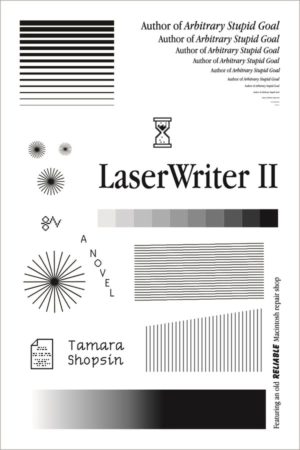LaserWriter II
by Tamara Shopsin
reviewed by Olive Fellows
There’s nothing quite like the moment of panic when your computer sputters and the screen goes black. Did something spill on it? Why won’t it turn back on? An even more chilling thought comes to mind: was it backed up recently? If you were a Mac user and had these questions in 1990s New York City, you would race to Tekserve, the legendary Macintosh repair shop, hardware in hand, hoping to God they could help you.
The longstanding shop closed its doors in 2016, but LaserWriter II, the succinct and quirky debut novel from Tamara Shopsin, illustrator for the New York Times and the New Yorker and author of the memoirs Arbitrary Stupid Goal and Mumbai New York Scranton, brings it back to life. Readers get an authentic look inside Tekserve through the eyes of Claire, a new employee, since the novel is based in fact.
At the start of LaserWriter II, the introverted yet idealistic nineteen-year-old Claire, whose meager résumé doesn’t even include the Columbia University classes she’s been illegally auditing for a semester, starts working at the TekServe intake station, where customers panic over the computer or printer problems they’re facing. Technicians—“Teks,” as they’re endearingly called at Tekserve—dutifully listen and troubleshoot. At TekServe, Claire learns about everything from Apple warranties to the “dark art” of data recovery.
As Claire gets to know the other employees, we’re given quick but entertaining snapshots of their lives and personalities; we come to meet even more Teks once Claire gets a promotion. She starts repairing printers—primarily the long-discontinued Apple models—and it’s here that Claire clicks neatly into place. She loves the work, rapidly learning the language of the machines and their unique music:
She unwraps the printer like a present. The ohm of the vacuum hums in her bones. Inside the LaserWriter II, the universe makes sense. Claire visits each part, folding the blankets of dust. She enters the black heart and wishes she could polish the ends of her own mirror.
The harmony of a hundred pages sound. The LaserWriter II has been purged of its ghost.
Such language betrays the spiritual aspect of LaserWriter II, which draws inspiration not merely from one religion but several. Teks abide by a certain code of conduct: they endeavor to do right by their customers. They have a “Tao,” which instructs them not to interrupt customers during the intake process. Teks wear antistatic bracelets, which prevent the electricity generated by the body from frying the circuit board during repairs, but also make them one with the machine.
At the same time, the job itself entails a kind of Christian resurrection. “My computer died,” we say when the screen goes black. In this novel, it’s the Teks’ job to purify and breathe life into it once more. When Claire finishes talking a customer through a driver update over the phone, Shopsin writes, “it is a true triumph for both when the trumpets of his printer’s paper feed sound.” There’s a cheeky echo here of 1 Corinthians 15:52: “For the trumpet shall sound, and the dead shall be raised incorruptible, and we shall be changed.”
After her promotion, Claire powers through tickets, doing work she feels makes a difference. But, even though we’re not given access to her innermost thoughts, there are clues she’s in too deep. Periodic sections wherein machine parts philosophize and voice their woes to one another add a surreal element to LaserWriter II and hint that Claire is getting visions, but not in the way of Steve Jobs.
For a book about tech problems—those dreaded, nightmare-inducing scenarios in which all our hard work and digital valuables disappear into the ether, rendering us temporarily, technologically useless—LaserWriter II is surprisingly fun to read. It’s hardly the coming-of-age tale the synopsis promises, given how beige Claire is as a character, but her brief, all-consuming interlude in the holy realm of machine repair is endearing and unique.
Published on March 10, 2022

